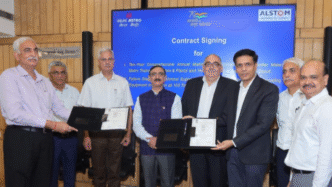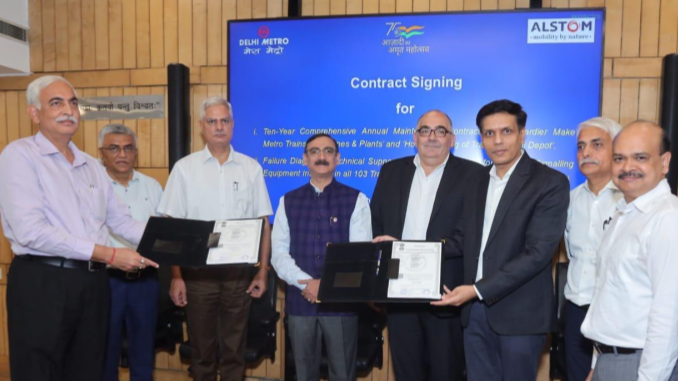Delhi Metro Rail Corporation (DMRC) has signed a 6-year agreement with Alstom Transport India Limited to enhance signalling reliability on the Red (Line-1) and Yellow (Line-2) Lines. The partnership will provide technical support, system audits, and data-driven upgrades, ensuring better performance, safety, and long-term efficiency for passengers.
Introduction:
Delhi Metro Rail Corporation (DMRC) has entered into a strategic contract with Alstom Transport India Limited (ATIL) to reinforce the reliability and operational performance of its Red (Line-1) and Yellow (Line-2) corridors. These lines, among the first to be introduced into the network, have been operational since 2002 and 2004, routes used by millions of passengers daily. DMRC has gone for this partnership as they need a reliable partner to help them in the modernization and sustained efficiency of the Lines.
Signing of the Agreement:
The contract was officially signed by Shri Manuj Singhal, Director (Infrastructure), DMRC, and Shri Sachin Deora, Director (Commercial), ATIL. The signing event took place at Metro Bhawan and witnessed the presence of Dr. Vikas Kumar, Managing Director of DMRC, along with senior officials from both organizations. To maintain global standards of urban metro operations in Delhi the agreement was a much needed solution.
Scope of the Contract:
The contract is structured for six years, with a possible two-year extension. The focus is on upgrading existing signalling systems, which currently operate on Distance To Go (DTG) technology. Key deliverables under the agreement include:
- Adequate onboard spares availability to minimize downtime.
- Upgradation of data logging facilities for in-depth failure analysis.
- Continuous backend technical support from Alstom’s global pool of experts.
- System audits and performance reviews to identify and rectify operational issues.
Importance of the Red and Yellow Lines:
The Red and Yellow Lines are critical backbones of the Delhi Metro network. The Red Line connects Rithala to Shaheed Sthal in Ghaziabad, while the Yellow Line links Samaypur Badli to HUDA City Centre in Gurugram. Together, they account for some of the highest daily ridership figures, making their reliability central to the city’s public transport ecosystem.
By ensuring signalling efficiency, DMRC aims to further reduce failures, improve punctuality, and offer passengers a comfortable commuting experience.
Alstom’s Role:
Alstom, a global leader in rail technology, brings its global expertise in metro signalling systems to this project. The company will not only provide technical support but will also play an instrumental role in diagnostics and rectification of failures. This ensures that the oldest metro corridors continue to perform at par with global benchmarks in urban rail reliability.
Strategic Impact:
The collaboration represents a broader vision of DMRC to continuously upgrade its infrastructure. With signalling being the backbone of metro operations, this initiative emphasizes safety, efficiency, and passenger comfort. Additionally, the agreement supports DMRC’s mission of adopting global best practices and leveraging OEM expertise to keep Delhi Metro future-ready.
Conclusion:
The DMRC-Alstom alliance is a crucial initiative posed to upgrade critical signalling systems of Delhi Metro’s busiest lines. With proper timely technical support, spare management, and system audits, the agreement will ensure higher efficiency, safety, and reliability. This development will reinforce DMRC’s role as a prominent leader in India’s urban mobility landscape.
Source: DMRC – Press Release | Image Credit: DMRC
[Nominations are Open] Submit your nomination (free) for the 7th Rail & Metro Awards 2026: Link
![]() Timely insights, straight to your WhatsApp—stay updated with ease!
Timely insights, straight to your WhatsApp—stay updated with ease!
![]() Stay connected to the rail industry—timely news, straight to Telegram!
Stay connected to the rail industry—timely news, straight to Telegram!


